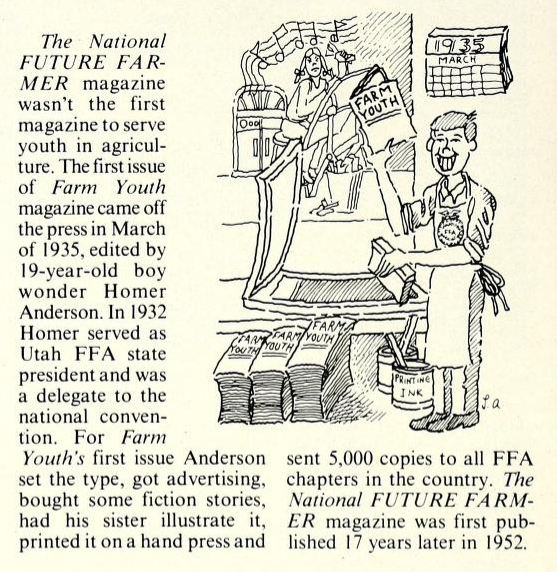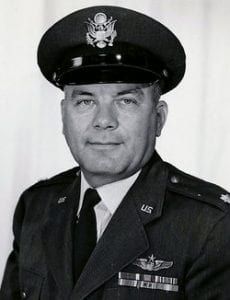Before video games, computers and television, there was something known as reading. However, it was a challenge to find good reading materials for rural young people during the early days of agricultural education. Ninety-two percent of rural residents had limited access to libraries (Streeter, 1940). Rural electrification was yet to come in many areas. After the sun went down in rural areas reading or going to bed were the primary options.
During the early days of agricultural education, reading was enthusiastically promoted. For years the FFA Manual contained a section recommending books that were appropriate for the members. Establishing chapter libraries was in the national FFA Program of Work.
The idea of having an FFA Magazine for the members emerged early in the history of the FFA. The minutes of the 1929 National FFA Convention (the 2nd convention) contain a statement from Henry Groseclose, the Executive Secretary-Treasurer of the FFA (p. 5-6) “Two publishers of agricultural magazines have asked to be allowed to publish a national magazine for boys to be known as the ‘Future Farmer Magazine’. While we believe that a national magazine is a thing greatly to be desired there is no tendency on the part of the Board of Trustees to rush headlong into such a project. This matter, however, will probably be settled at the next annual congress.”
The words of Groseclose that the Board would not “rush headlong into such a project” were prophetic. It was not until 1952 that an official FFA magazine appeared. In the booklet “FFA at 25” (published by the FFA in 1956) it is stated (p. 43) “There was one-long standing desire that the Future Farmers never had been able to achieve: to have their own national magazine. Since the organization’s earliest days, there had been action in national conventions calling for the establishment of a national magazine, but one reason or another had cropped up at each time to cause delay.”
There is no discussion of what the problems were. My speculation is that in the beginning, the finances were not adequate to support a magazine. National dues were only 10 cents and the organization was $191 in debt after the first year. Then there was the great depression followed closely by World War II. Furthermore, the national FFA organization did not have a paid staff as it does today. The FFA was operated out of the Agricultural Education Service of the Federal Board for Vocational Education. The federal officials probably did not consider publishing a magazine to be in their job description.
However, an ambitious FFA member, unlike the cautious adults, took the initiative to create a wildly successful magazine – The American Farm Youth. Homer Andersen, was President of the Utah FFA and was a delegate to the National FFA Convention in 1932 (he was 16 years old). During the convention, the matter of having an FFA magazine was again discussed. The FFA Board of Trustees recommended (Proceedings, 1932, p. 15) “that the financial situation did not warrant” publishing a magazine at this time. The delegates concurred.

Homer went back to Utah but the idea of a magazine lingered in his mind. In March of 1935, he began publication of The American Farm Youth in Hyrum, Utah. It was a little 6 x 9 magazine printed on inexpensive pulp paper. He and his sister made the illustrations using linoleum blocks. To promote the magazine and attract subscribers, 5,000 copies were printed and mailed to all the FFA chapters in the country.
After printing four issues he determined that he needed to step up his game; so at the age of 19, he moved to Danville, Illinois – the home of Interstate Printers. Russell Guin, the President of Interstate, helped Homer with the magazine. The magazine had a small staff. In addition to Homer, Bob Romack (24) of Danville handled the advertising and Daun Larsen (21) from Hyrum Utah was the circulation manager. Harl Son, Jr. (20) of Danville was the hunting and fishing editor.
According to an article in the Danville Commercial-News (1935, September) the magazine caters to all farm youth but principally to members of 4-H Clubs and Future Farmers of America. It contains fiction, scouting news, aviation information, hobby items, FFA features, humor, outdoor life news, stamp collectors information and other departments.
Starting with 300 subscribers it grew to 13,000 subscribers in just two years. Over time, the publication continued to attract subscribers. The October 1956 issue states on the cover “This Issue Read By More Than A Quarter Million Young Farmers.” It appears the magazine was a great success and filled the void created by the FFA not having a magazine.

At first, the National FFA was supportive of this publication. The minutes of the FFA Board of Trustees for October of 1935 indicate the following resolution was unanimously passed by the delegates at the annual convention:
“Encourage the efforts of Homer Paul Anderson, Editor of The American Farm Youth Magazine” and suggesting further cooperation and support from the F.F.A.”
However, the relationship soured between Andersen and the FFA the following year. The minutes of the FFA Board of Trustees in April of 1936 has over a page of discussion about the Magazine. The trustees were upset about the use of the FFA emblem on the front cover, the statement that this was “The only national publication for F.F. A. chapters”, the advertisement for the sale of stuffed owls, and advertisements for the Chapter Supply Company (which was owned by Bob Romack, the advertising manager for the magazine). Andersen agreed to cooperate with the board more on matters related to policy.
Apparently, this cooperation didn’t work. The October 1936 minutes of the FFA trustees contains the following: “It was moved, seconded and carried that the Board of Trustees was not to give in any manner whatsoever a promise, hope, consulation (sic), sympathy or assistance to Mr. Homer Paul Andersen, Managing Editor, American Farm Youth on the publication of a National F.F.A. Magazine.”
At some point in time (I don’t know exactly when but between 1936 and 1939) the magazine changed hands to a group in Danville, Illinois (probably because Homer moved to Denmark to serve as Missionary for his church). The advertising manager, Bob Romack, was the primary (or perhaps sole) owner. The magazine continued to operate until March of 1962 (the National Future Farmer started in 1952; so they competed for 10 years). Finding copies of The American Farm Youth is challenging. I personally own two issues – October 1939 and October 1956. They have been scanned in case you want to look at them (just click on the links).
I can’t find any copies of The American Farm Youth that have been scanned and are online. My research indicates that copies exist in only a handful of university libraries (University of Tennessee, Fort Valley State, Cornell, Michigan State, Southern Illinois, University of Illinois, University of Wisconsin-Madison, Iowa State, University of Minnesota, Indiana University-Purdue University at Indianapolis, and Oklahoma State.) Perhaps some Ag Communication or Ag Ed folks at these universities could scan them and put them online.
So who was Homer Paul Andersen?

There is no cohesive biography of Homer. Following are fragments from various sources.
Homer was born in 1915 in Hyrum, Utah. His father was an agriculture teacher. During four years of high school, his farming program consisted of dairy cattle, hogs, sugar beets, peas, and beans. He showed Holstein cattle and Duroc hogs at fairs. He was an Eagle Scout with 46 merit badges and attended the International Scout Jamboree in England. He attended Utah State University for two years. Before moving to Danville he had been in the Utah National Guard. In 1938 he was in Denmark serving as a missionary for the Mormon Church. In 1940 Homer Paul Andersen authored a book titled “Your Career in Agriculture”. The publisher was Dutton & Company of New York. Homer is identified as the former Assistant Editor of Boys’ Life (which was news to me). He also married in 1940.
Homer was a pilot in World War II, his plane, a B-17 was shot down over Germany and he spent two years in a prisoner of war camp. Later, he was in charge of the ROTC program at the College of Southern Utah and at Brigham Young University and was also stationed at Air Force bases across the country and abroad. He was editor of the Air Force magazine for many years. Prior to his Air Force career he served as editor of the Deseret News Church Section. He died unexpectedly on May 24, 1962. He was 46 years old.

Doing research on Homer was a challenge. Depending upon the source he has been identified as Homer Carl Andersen, Homer Paul Anderson, and Homer Paul Andersen. His grave marker says Homer Paul Andersen, so that is what I am going with.
Teaching Ideas:
- When you teach about SAE Entrepreneurship you could have the students read this document. What characteristics did Homer exhibit that entrepreneurs need to possess?
- If you teach Agricultural Communications, have your students look at one of the issues of The American Farm Youth and compare the contents and layout to the FFA New Horizons Magazine. What are the strengths and deficiencies of each?
- For college professors, if you teach about Rogers’ Stages of Adaption of Innovation you could have your students compare and contrast where Homer Paul Andersen and the National FFA Organization fell on the adoption curve in regards to a national publication and speculate as to why.
References:
- Danville (IL) Commercial-News (Sept. 1935; April 10, 1938)
- FFA at 25 (1956). Future Farmers of America.
- Minutes of the FFA Board of Trustees (https://archives.iupui.edu/handle/2450/283)
- Proceedings of the National Convention of Future Farmers of America (https://archives.iupui.edu/handle/2450/2398/browse?type=dateissued)
- Streeter, C. P. (1940, Jan). Who’ll start the library? Farm Journal and Farmers Wife. 37, 61.
